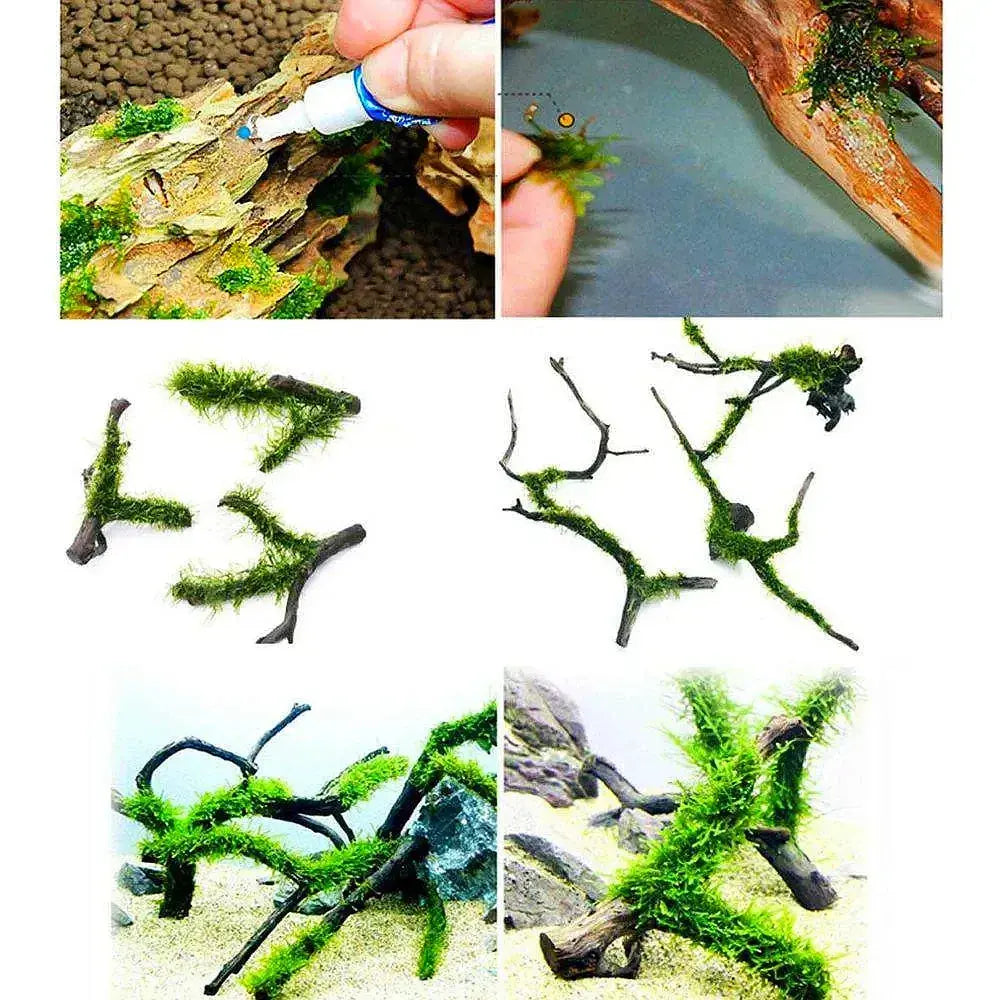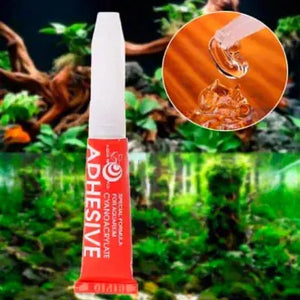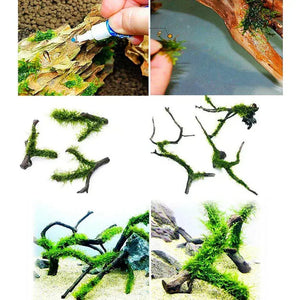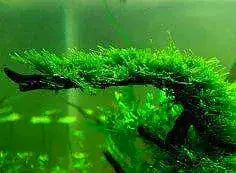Aquarium Cyanoacrylate Glue
Order today - receive it in as little as 3-5 days.
Return within 30 days of purchase. Duties & taxes are non-refundable.
Guarantee Safe Checkout
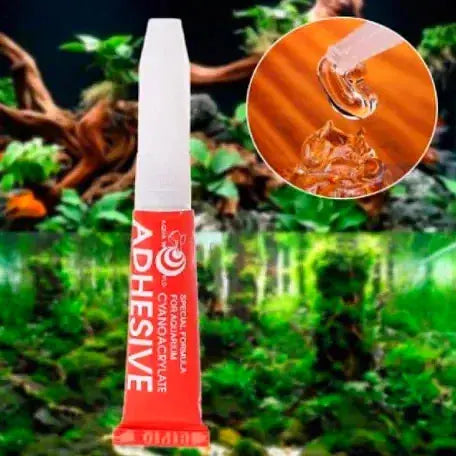
Aquarium Cyanoacrylate Glue
Moss Glue: Aquarium Cyanoacrylate Adhesive Glue – Your Complete Guide
Keeping an aquarium vibrant and thriving is a true passion for many Australians. Whether you're just starting out or already experienced, the secret to a beautiful aquascape often lies in the small details. One of the most essential tools for aquascapers is aquarium cyanoacrylate adhesive glue, also known as moss glue. This complete guide walks you through everything you need to know about this safe, versatile, and aquarium-friendly adhesive.

Key Takeaways
- Aquarium cyanoacrylate adhesive (moss glue) is essential for aquascaping and long-term tank stability.
- Marine-safe, reef-safe adhesive protects fish, plants, corals, and invertebrates.
- Understanding glue type, curing time, and strength helps you choose the right product for your setup.
- Correct application techniques improve aesthetics and durability in your underwater layout.
- Expert advice from trusted aquarium specialists can help you get the most from your aqua glue.
Understanding Aquarium Cyanoacrylate Adhesive Glue
Aquarium lovers know that using the right adhesive matters. Cyanoacrylate adhesive, often called “aquarium glue” or “moss glue,” has become a favourite among both hobbyists and professionals. It’s ideal for building beautiful underwater landscapes that are also structurally sound.
Chemical Composition & Properties
Cyanoacrylate adhesives cure rapidly and form strong bonds, even in wet or submerged conditions. The gel version is thicker and easier to control than the liquid form, making it perfect for precise aquascaping tasks like attaching moss, plants, or coral fragments onto rocks and driftwood.
Safety Features for Aquatic Life
One of the biggest advantages of aquarium-grade cyanoacrylate is that it is non-toxic when cured and safe for aquatic life. Formulations labelled as aquarium-safe or reef-safe are specifically tested to ensure they do not harm fish, shrimp, snails, plants, or corals. This makes them a reliable choice for any freshwater or marine system.
Types of Aquarium Applications
- Attaching decorative elements such as rocks, driftwood, and ornaments
- Securing live plants, mosses, and ferns to hardscape or substrate
- Bonding coral fragments (frags) to plugs or rocks in reef tanks
- Fixing loose or detached aquarium components and décor
- Temporary repairs to chipped or cracked glass or acrylic (short-term solution only)
Benefits of Using Marine-Safe Adhesive in Your Aquarium
Choosing the right adhesive is crucial for the long-term health and appearance of your tank. In Australia, many aquarists rely on reef-safe cyanoacrylate, often called “super glue for aquariums” or “aqua glue,” because it combines strong bonding power with a high safety profile.
This type of glue:
- Bonds quickly – allowing you to attach moss, plants, and decorations in seconds.
- Lasts underwater – designed to handle constant submersion and tank currents.
- Protects your livestock – formulated to be safe for fish, invertebrates, and corals.
In short, using a reef-safe marine adhesive is a smart choice for anyone building a stable, attractive aquascape without compromising the health of their aquarium inhabitants.
How to Choose the Right Aqua Glue for Your Tank
With so many adhesives available, it can be tricky to know which one to choose. Understanding the differences between gel vs liquid, as well as curing time and bond strength, will help you pick the ideal aquarium-grade adhesive for your project.
Gel vs Liquid Formulations
Aquarium glues typically come in two main forms:
- Gel glue – Thicker, stays where you put it, and is perfect for attaching moss, plants, and coral frags.
- Liquid glue – Thinner, flows into small gaps and is better suited for tight joints and fine repairs.
For most aquascaping and coral work, gel cyanoacrylate is the preferred choice.
Curing Time Considerations
- Fast-curing glues are convenient but may allow less adjustment time.
- Slower-curing formulas offer more flexibility for positioning before the bond sets.
- Consider whether precision placement or speed is more important for your task.
Strength and Durability Factors
| Feature | Benefit |
|---|---|
| High tensile strength | Creates strong, long-lasting bonds that resist movement underwater. |
| Waterproof formula | Maintains its hold even when fully submerged for extended periods. |
| Flexibility | Allows plants and décor to move slightly without breaking the bond. |
Best Practices for Applying Reef-Safe Cyanoacrylate

Using a marine-safe adhesive correctly is just as important as choosing the right one. Good technique helps you achieve clean, strong, and long-lasting bonds.
Step-by-Step Application Guide
- Prepare the surface: Clean and dry the area you want to glue. Remove algae, slime, or debris.
- Apply a thin layer: Use a small amount of glue—thick blobs can look messy and take longer to cure.
- Press and hold: Position the item and hold it in place for 30–60 seconds so the glue can set.
- Adjust quickly if needed: Make any small adjustments within the first 30 seconds.
- Allow full cure time: Avoid touching or disturbing the bond for at least 24 hours.
Following these steps will help you create reliable bonds that keep plants, corals, and decorations securely in place for the long term.
Common Applications for Aquarium-Grade Adhesive
Aquarium-grade cyanoacrylate and “super glue for aquariums” are incredibly versatile. Here are some of the most common ways aquarists use them:
Attaching Moss and Plants
A small dab of gel glue can be used to attach moss, ferns, and other plants onto rocks, driftwood, and décor. Over time, they grow and spread, creating a natural, lush aquascape that stays anchored where you want it.
Securing Coral Fragments
In reef tanks, cyanoacrylate gel is the go-to choice for mounting coral frags to plugs or live rock. It provides a strong, reef-safe bond that allows coral colonies to grow, spread, and form a stable coral garden.
Fixing Decorative Elements
Super glue can also repair broken ornaments, stabilise loose rocks, or hold sections of hardscape together. Because it cures underwater and maintains strength, it’s ideal for structural and cosmetic fixes inside your tank.
Troubleshooting Tips for Waterproof Glue Application
Even with experience, glue application in an aquarium setting can sometimes be tricky. Here are some simple troubleshooting tips to help you get better results.
Dealing with Excess Glue
If you’ve used too much glue:
- Gently blot the excess with a clean, dry cloth instead of wiping.
- If it has already cured, carefully trim off any visible excess with a small pair of scissors or a blade.
Fixing Weak Bonds
If your bond feels weak or breaks easily:
- Lightly roughen both surfaces with fine-grit sandpaper to improve adhesion.
- Ensure surfaces are clean and as dry as possible before re-applying glue.
- Apply a thin, fresh layer of adhesive and hold firmly until it sets.
Clearing Cloudy Water
Occasionally, using too much glue at once may cause temporary cloudiness in the water:
- Perform a partial water change and use a gravel vacuum if needed.
- Avoid squeezing large amounts of glue directly underwater in future applications.
Professional Tips from Micro Aquatic Shop Experts
At Micro Aquatic Shop, our team has years of hands-on experience working with aquarium-grade adhesives. Here are some expert tips to help you get the most from your cyanoacrylate gel or marine-safe glue.
Storage and Maintenance
- Store your glue in a cool, dry place away from direct sunlight.
- Always close the cap tightly after use to prevent the nozzle from drying out.
- Avoid exposing the tube to extreme temperatures to maintain performance.
Application Techniques
- Use a toothpick or fine applicator for small or delicate spots.
- Apply multiple small dabs rather than one large blob for cleaner results.
- Hold décor or plants in place just long enough for the initial set, then leave undisturbed.
Safety Precautions
- Use in a well-ventilated area and avoid breathing in fumes directly.
- Wear gloves to prevent skin contact where possible.
- If glue gets on skin, gently remove it with warm soapy water—do not pull or tear at bonded skin.
- Keep all adhesives away from children, pets, and open flames.
Conclusion

Aquarium cyanoacrylate adhesive glue is one of the most useful tools for aquascapers and hobbyists. Whether you’re securing coral frags, attaching plants and moss, or fixing decorations, the right aqua glue can make a huge difference in both appearance and stability.
Choosing a reef-safe, fish-safe cyanoacrylate ensures your aquarium stays healthy while you build the scapes and reef structures you’ve always imagined. Combined with proper application and a bit of patience, this simple product becomes a powerful ally in creating a stunning underwater world.
For high-quality aquarium-safe adhesives and expert advice, explore the range available at Micro Aquatic Shop and take your aquascape to the next level.
FAQ
What is aquarium cyanoacrylate adhesive glue?
It is a special type of cyanoacrylate (super glue) formulated to be safe for use in aquariums. It can be used to attach plants, moss, coral, and decorations underwater without harming fish or other aquatic life once cured.
How is aquarium-safe glue different from regular super glue?
While both are based on cyanoacrylate, aquarium-safe formulations are tested to be non-toxic for aquatic environments. Regular super glue from hardware stores may contain additives or packaging residues that are not recommended for direct use in fish tanks.
Can I use this glue to attach live coral fragments?
Yes. Gel-type aquarium cyanoacrylate is widely used for mounting coral frags in reef aquariums. Apply a small amount to the base of the frag, press it onto the rock or plug, and allow it to set before returning it fully to the main flow.
Should I choose gel or liquid glue?
For most aquascaping tasks—especially attaching moss, plants, or coral—gel glue is the better option because it stays in place and is easier to control. Liquid glue is more suited to tight cracks or fine repairs where you need the adhesive to flow into small spaces.
Is it safe to apply the glue underwater?
Many aquarists do apply small amounts of gel glue underwater, especially when fixing corals. Just avoid squeezing out large blobs directly into the water. For best results, you can apply glue outside the tank when possible, then place the item back in once the initial bond has formed.
How long does the glue take to fully cure?
The initial bond usually forms within seconds to a minute, but for maximum strength and safety, it’s best to avoid disturbing the glued area for at least 24 hours.
| Quantity |
1 glue |
|---|

